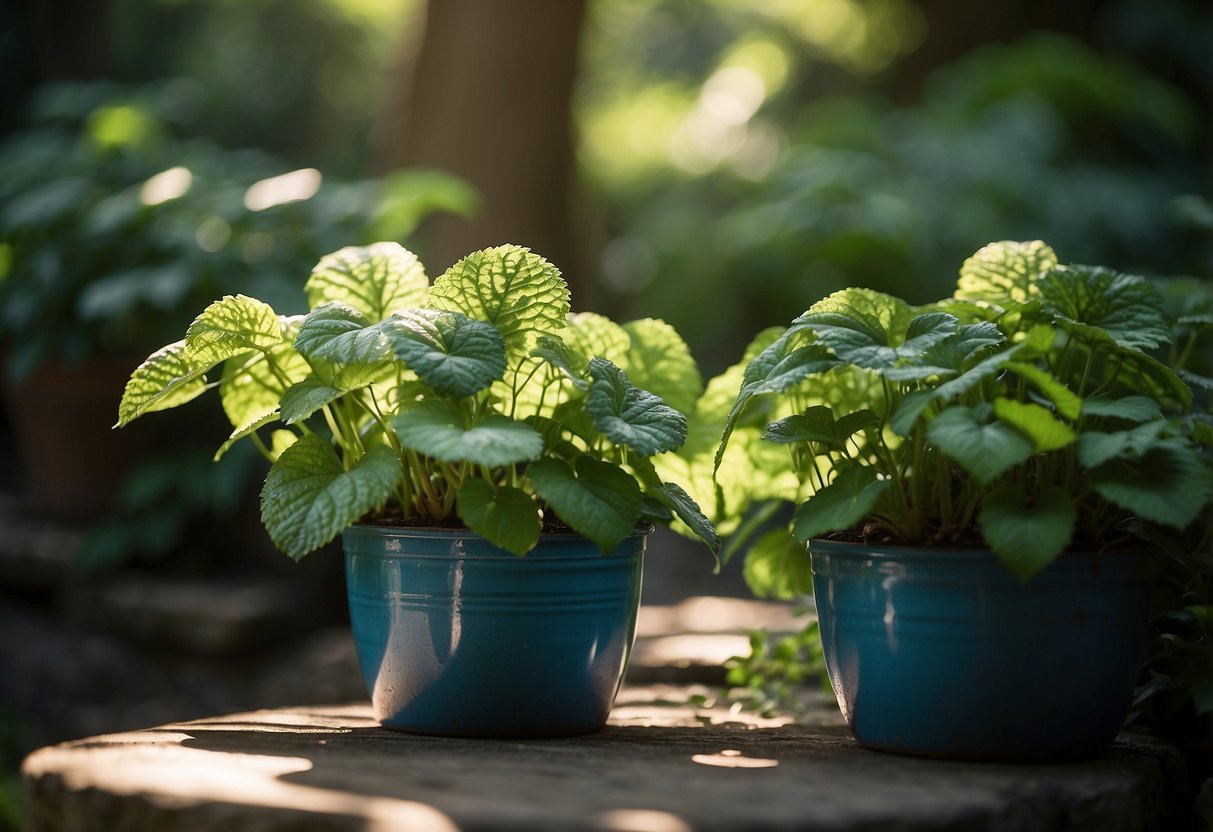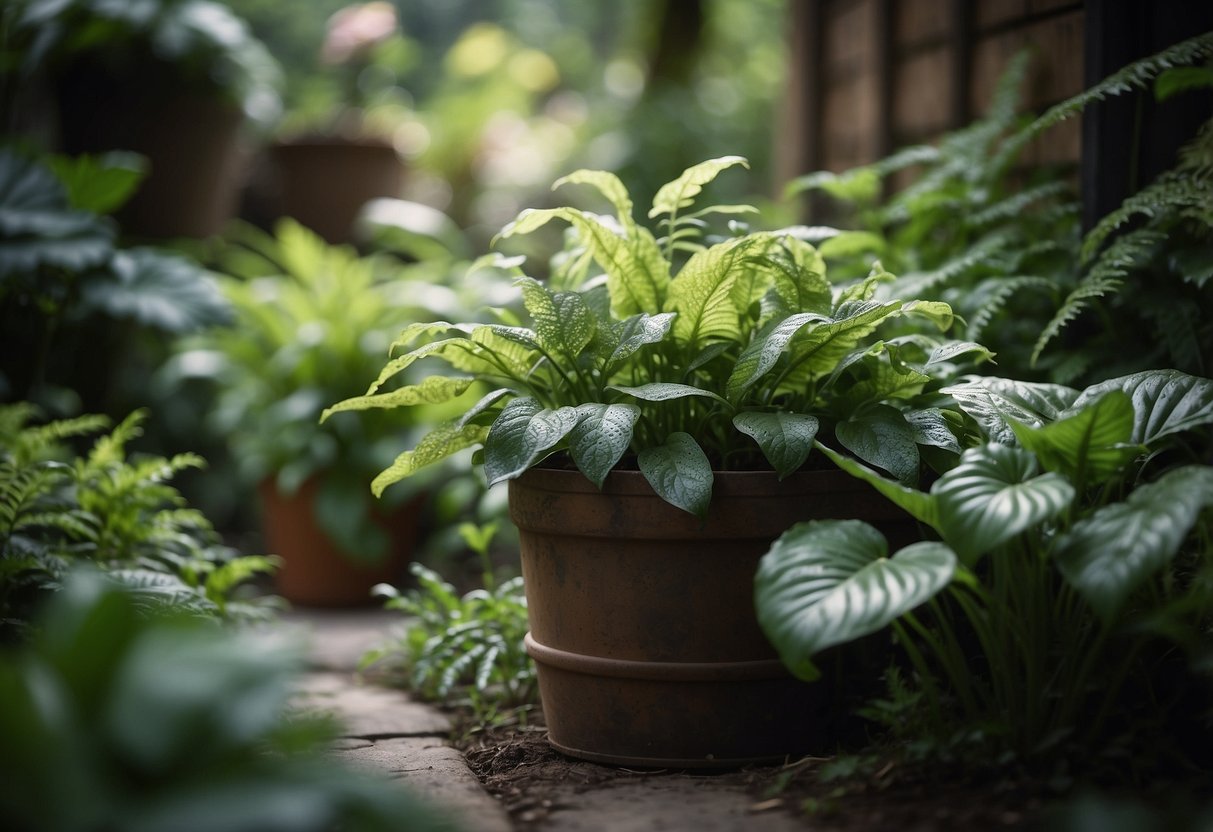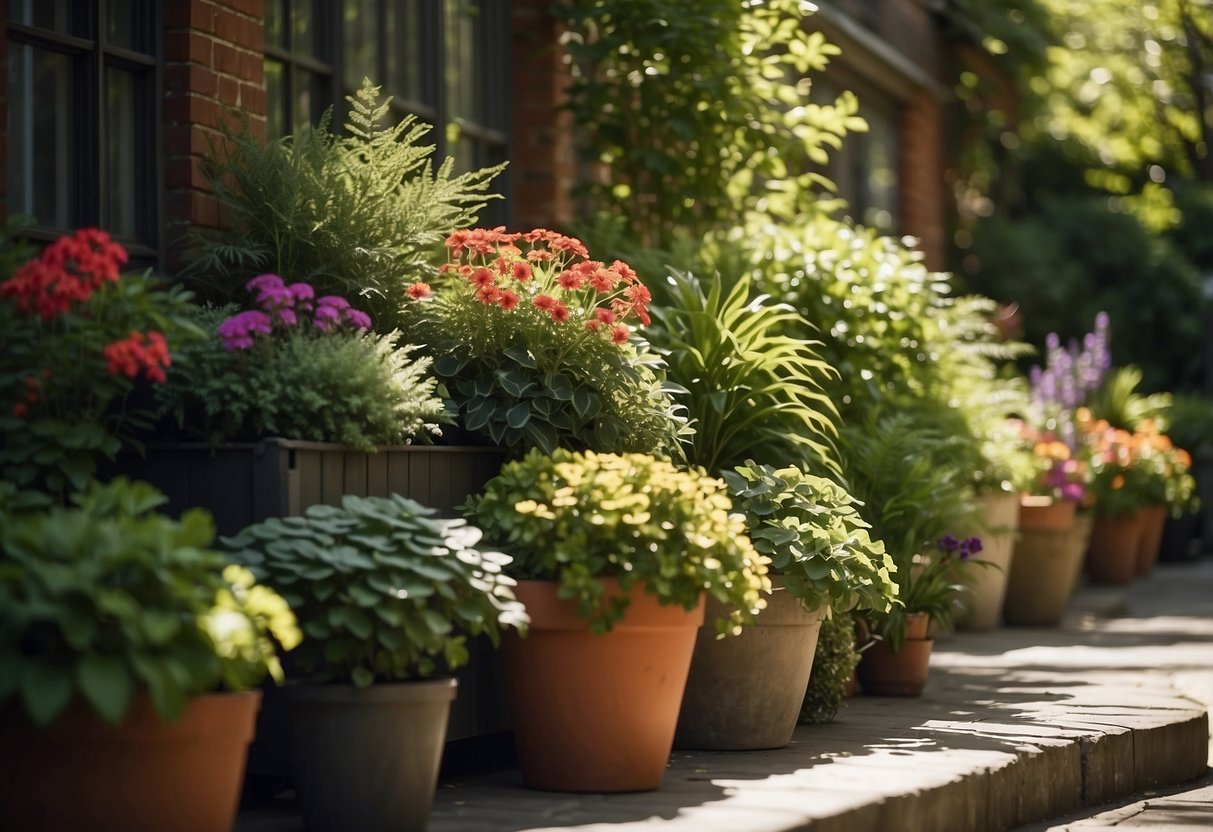Container Garden Ideas Shade: Creative Tips for Lush, Shady Spots
Creating a vibrant garden in a shaded area can seem like a tough challenge, but there are plenty of stunning container garden ideas that thrive away from the sun. Whether you have a shady porch, balcony, or a corner in your yard, you can still enjoy a beautiful array of plants.

You can transform any shady spot into a lush, green haven with the right container garden combinations. Imagine lush ferns, colorful begonias, and trailing ivy all adding texture and interest to your space. Container gardening in the shade not only maximizes your available growing area but also brings life to those dim, forgotten corners.
1) Hostas

Hostas are a wonderful choice for shady container gardens. Their large, lush leaves bring a tropical feel to your garden space. You can find them in many sizes and colors, which makes them easy to mix and match.
Consider placing a single Hosta variety in a decorative pot. This can create a standout feature for your patio or deck. For more ideas, visit Proven Winners.
If you want variety, try combining Hostas with other shade-loving plants for an eye-catching display. For inspiration, check out Balcony Garden Web.
2) Ferns

Ferns are great for shaded container gardens. They thrive in low light and bring a touch of greenery to any space.
Soft shield fern and Western sword fern are popular choices. These ferns grow well in pots and don’t need much maintenance.
You can also try the cinnamon fern. Its unique, reddish-brown fronds add a splash of color to your garden.
Ferns prefer moist, well-drained soil. Keep their soil damp but not soggy for best results.
3) Heuchera

Heuchera, also known as coral bells, is perfect for adding color to your shade garden. They thrive in partial shade and come in many vibrant leaf colors like deep purple, bright green, and pink.
Use a container at least 6 inches wider than the root ball, but they don’t need a tall pot. Heuchera prefers well-draining, humus-rich soil.
For more information on growing Heuchera, visit this guide.
4) Astilbe

Astilbe is a wonderful choice for your container garden in shady areas. Its beautiful, feathery plumes add a splash of color to any spot.
To grow Astilbe in pots, use a container with drainage holes. Fill it with a mix of loam, peat moss, and compost.
Keep the soil consistently moist and place the pot in partial shade. Monthly fertilizing during the growing season helps too.
Ready to brighten up your garden with astilbe? Learn more about how to take care of these lovely plants.
5) Foxglove

Foxgloves add a touch of elegance to your shade garden. They come in many varieties, some of which prefer partial shade. You can easily grow foxgloves in containers and move them around to ensure they get the perfect amount of light.
Look for large containers since these plants can grow up to 5 feet tall. Start with well-draining soil and water thoroughly.
Foxgloves are biennials, so they won’t bloom until their second year. Patience will reward you with stunning, tall flowers that attract pollinators to your garden.
For more tips, you can explore this guide on growing foxgloves in pots.
6) Brunnera

Brunnera is a great choice for shaded container gardens. It features heart-shaped leaves and lovely blue flowers.
You’ll want to plant Brunnera in the spring. This gives it time to establish roots before winter.
Find a spot that gets full shade or morning sun. Use well-rotted compost if your soil needs it. Dig a hole as deep and twice as wide as the plant’s root ball for best results.
Brunnera can thrive in mixed borders, mass plantings, or as edging. It also works well on shady slopes to help stop erosion.
For easy care, water it once or twice a week during summer. Placing plants 12-14 inches apart ensures they have enough space to grow. This makes Brunnera not only beautiful but also a practical addition to your shade garden.
7) Lungwort

Lungwort is a fantastic choice for your shade container garden. It thrives in partial to full shade, making it perfect for less sunny spots. Its beautiful foliage and colorful flowers add charm to any garden space.
Place Lungwort in glazed ceramic, plastic, or metal containers. Make sure the container is about 18 inches for one to two plants. The unique appearance of Lungwort will attract hummingbirds and bees to your garden, making it a lively and dynamic space. For more details, check out this guide on Growing Lungwort in Pots.
8) Coral Bells

Coral Bells are a fantastic addition to your shade garden. Their colorful leaves can brighten shady spots with shades of purple, red, and green. The compact mounds they form fit well in small containers.
These plants thrive in a container with a drainage hole and well-draining soil. They are easy to pair with other shade-loving plants like hostas or ferns. You can place them in partial shade to full shade. Coral Bells also attract butterflies with their small flowers.
For more information, you can visit 10 Coral Bells to Spice-Up the Shade Garden.
9) Toad Lily

Toad Lily is a perfect addition to your shade container garden. Its unique, orchid-like flowers bloom in late summer to early fall, adding color to those darker spots.
Plant your Toad Lily in a container with moist, rich soil. Place it in a shady or partly shady spot. Water regularly to keep the soil consistently moist. For more details, visit How to Grow and Care for Toad Lily – The Spruce.
10) Bleeding Heart

Bleeding Heart is a perfect choice for your shade garden. These lovely flowers thrive in dappled or partial sunlight. They bloom from early spring to the start of summer.
Ensure you plant them in well-drained soil and use a quality potting mix. Containers should be large, around 12 inches, with good drainage. Regular watering is key, but avoid soggy conditions.
This plant is native to Asia and can add charm to your garden with its delicate look. For more tips on growing Bleeding Heart in containers, visit Gardener’s Path.
Understanding Shade In Container Gardens

Shade is crucial for certain plants that don’t thrive in full sun. Understanding the types of shade and its benefits for plants can help you create a successful container garden.
Types of Shade
Partial shade gets 2 to 4 hours of sunlight each day, usually in the morning or late afternoon. This pattern works well for plants needing some direct light but can’t tolerate intense midday sun.
Full shade means little or no direct sunlight, only reflected or indirect light. Spaces like under trees or next to buildings often provide this type of shade.
Dense shade offers very minimal light and is found in areas like dense forests or heavily built-up urban environments. It’s tricky for many plants, but there are shade-loving species that can flourish in these conditions.
Benefits of Shade for Plants
Shade helps reduce water evaporation, meaning you won’t need to water your plants as frequently. This is especially useful during dry spells or if you have a busy schedule.
Shade also helps prevent sunburn and heat stress in plants that are not tolerant of intense sunlight. This leads to healthier growth and vibrant foliage.
Additionally, shady areas provide good conditions for growing plants like ferns and hostas, which thrive without full sun. These plants can add unique textures and colors to your garden, making it more visually appealing.
By utilizing shade, you can create a diverse and sustainable container garden that meets the needs of a variety of plants.
Choosing the Right Plants for Shade

Finding the perfect plants for your shade garden means picking those that thrive in low light. Some hardy plants can handle shady spots well, while others will surprise you with their lovely flowers.
Hardy Shade-Loving Plants
Coral Bells: These plants are known for their colorful foliage. They come in shades like light green, deep purple, and golden caramel. They are hardy and require little maintenance, making them perfect for shaded areas. Check them out here for more information.
Elephant Ears: With their large, dramatic leaves, Elephant Ears like the ‘Red Stem Rhubarb’ can be a great addition. They grow best in partial to full shade and need moist soil. They’re eye-catching and add a tropical feel to your garden.
Oxalis: This plant has unique foliage and small, beautiful flowers. Species like Oxalis versicolor, O. triangularis, and O. tetraphylla do well in shady conditions. They offer interesting textures and can be a great fit for your containers. Explore more about Oxalis here.
Flowering Plants for Shade
Impatiens: These flowers come in colors like pink, red, orange, and white. Impatiens can brighten up dark spots and grow well in partial to full shade. They bloom abundantly and are easy to care for, adding vibrant hues to your container garden.
Begonias: Known for their long bloom time, Begonias are versatile plants for shaded areas. They come in a variety of flower colors and leaf patterns. They thrive in partial sun to shade and can be mounding, bushy, or upright, perfect for filling out a container garden. Learn more about Begonias here.
Hydrangeas: These plants prefer partial shade and can tolerate more shaded conditions. They produce large, stunning flowers in various colors. Hydrangeas are a great option for containers and can add a splash of color and elegance to your shady garden corner. More about Hydrangeas here.
Design Tips for Shade Container Gardens

Designing a shade container garden can be both fun and rewarding. By focusing on color, texture, and clever arrangements, you can create a vibrant and visually appealing garden that thrives without direct sunlight.
Using Color and Texture
In a shade container garden, color and texture play crucial roles. Brightly colored foliage, like that of the Coleus, can add striking visual interest. Some coleus varieties offer a palette ranging from deep purple to lime green. Another good choice is Coral Bells (Heuchera spp.), which come in shades of pink, purple, and gold.
Textures also make a big difference. Plants with different leaf sizes and shapes create contrast. For example, pairing the bold leaves of Elephant Ears (Colocasia ‘Red Stem Rhubarb’) with the delicate foliage of Sweet Potato Vine (Ipomoea batatas ‘Sweet Caroline Bronze’) can add depth and interest to your container garden.
Feel free to experiment with various plant combinations. Adding plants with both large and small leaves, as well as a mix of upright and trailing habits, can make your garden more dynamic.
Arranging Containers
Arrangement is key to making the most of your shade container garden. Using one large container as a centerpiece can provide a focal point. Surround this with smaller pots to create a balanced look and utilize space efficiently. Grouping pots together can also help retain moisture, a handy trick for shaded areas.
Think about the height and spread of your plants. For instance, Purple Fountaingrass (Pennisetum setaceum ‘Rubrum’) grows tall and can add vertical interest. Combine it with shorter plants like Impatiens ‘Dazzler Pink’ for a complementary effect.
Also, consider the interplay of light and shadow. Place lighter-colored plants in the darker corners of your garden to brighten them up. Conversely, darker plants can add depth to more illuminated areas.
Planning your container garden with these tips will help you create a lush, lively space even in the shade.







